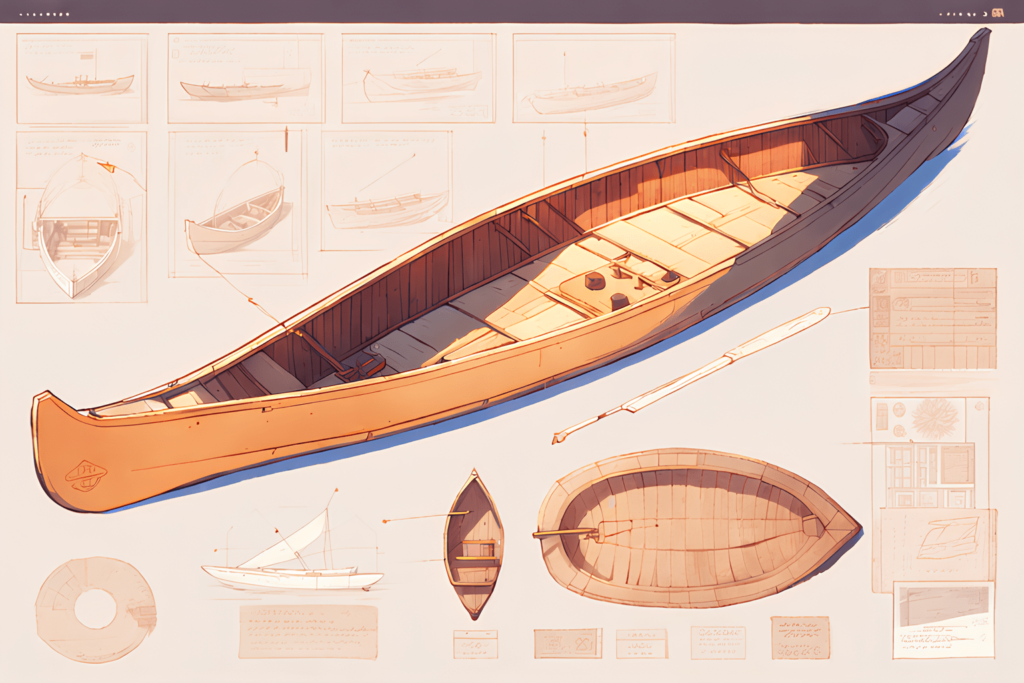Ever dreamed of making your own watercraft? It’s more than a hobby; it’s an art that turns simple materials into a unique floating work of art.
DIY canoe plans let you build amazing watercraft, from small 11-foot canoes to big 18.5-foot ones. Whether you love fishing or paddling, these plans help you make the perfect boat for you.
From picking cedar strips to mastering complex building steps, DIY Canoe Plans & Blueprints will help you every step of the way. You’ll learn to make a canoe that’s truly yours.
Key Takeaways – Canoe Plans & Blueprints
- Canoe plans range from 11′ to 18.5′ in length
- Different series cater to specific water activities
- Building a canoe requires skill, patience, and dedication
- Customization options allow personal design touches
- Proper planning is key for a successful build

Introduction to DIY Canoe Building
Making your own canoe is a thrilling adventure. It mixes woodworking skills with the joy of outdoor activities. Wooden canoe designs let you build a custom watercraft that shows off your skills and love for paddling.
Canoe building guides open a creative world for woodworking fans. It doesn’t matter if you’re new or have lots of experience. Building a canoe gives you a great feeling of achievement and connects you to the sea.
Benefits of Building Your Own Canoe
- Complete customization of design and features
- Cost-effective alternative to purchasing a pre-made canoe
- Develop advanced woodworking skills
- Create a unique, personalized watercraft
- Satisfaction of crafting your own adventure vessel
Overview of Canoe Types and Designs
Knowing about wooden canoe designs is key for those who want to build one. North America has five main types of canoes:
| Canoe Type | Key Characteristics | Typical Length |
|---|---|---|
| All Wood Design | Traditional craftsmanship | 15-18 feet |
| Canvas Canoe | Wooden frame with canvas covering | 14-16 feet |
| Aluminum Canoe | Lightweight and durable | 12-17 feet |
| Fiberglass Canoe | Modern material, smooth finish | 13-16 feet |
“Building a canoe is more than a project—it’s creating a personal connection with water and craftsmanship.”
For beginners, the Peace Canoe design is a great choice. It can carry over 600 lbs, perfect for family trips. The hull is 18’0″ long and 41½ inches wide, making it both versatile and stable.
Essential Tools and Materials Needed
Building a canoe needs careful planning and the right tools and materials. Guides for boat construction stress the need for a well-prepared workspace and quality materials. This ensures a durable small craft blueprint.
Making a canoe is a big project that takes time and money. It can cost about $1,500 and takes 300 hours to finish. If you want to build a boat, be ready for a long journey of learning and creativity.
Basic Tools for Canoe Construction
Here are the essential tools for building a canoe:
- Table saw
- Orbital sander
- Router
- Hand plane
- Drill
- Jigsaw
- Disc sander
“The right tools can transform your small craft blueprints from a dream to a reality.”
Selecting the Right Materials for Durability
Choosing the right materials is key for a long-lasting canoe. You’ll need:
- Cedar strips (3/4″ wide by 1/4″ thick)
- Ash for stems and gunnels
- 1/4″ plywood for molds
- Fiberglass cloth
- Epoxy resin
- High-quality varnish
Always wear protective gear like gloves and a respirator when working with epoxy and other materials. Safety is very important in boat construction guides.
| Material | Quantity | Purpose |
|---|---|---|
| Epoxy Resin | 3/4 gallon | Bonding and sealing |
| Fiberglass Tape | 11 yards | Reinforcement |
| Plywood | 3 sheets | Structural support |
Patience and a willingness to learn are more important than skills when starting your canoe-building journey.
Finding the Right Plans and Blueprints
Starting canoeing DIY projects means picking the right blueprints. The best kayak designs make building your boat a fun journey.
Choosing the right canoe plans is key. There are many options for DIY fans. Prices usually range from $105 to $135 for detailed blueprints.
Locating Quality Canoe Plans
Look for top kayak designs at these places:
- Specialized marine websites
- Professional woodworking forums
- Dedicated boat-building communities
- Marine supply stores
Understanding Canoe Blueprint Varieties
Canoe blueprints vary in design:
- Racing Canoes: Fast designs for competitive paddlers
- Expedition Canoes: Strong models for long trips
- Recreational Canoes: Flexible designs for casual use
- Solo Canoes: Small models for one paddler
“The blueprint is your roadmap to crafting the perfect watercraft.” – Experienced Boat Builder
When picking canoe DIY projects, think about the design’s complexity. Also, consider your skill level and what resources you have. Good blueprints include lists of materials, cut specs, and how to assemble it.
Unlock the secrets to building your dream boat with MyBoatPlans! With detailed plans for over 518 boats and expert video tutorials, you’ll have everything you need to create your perfect vessel. Click here to begin your journey!
Step-by-Step Guide to Canoe Construction
Starting a DIY canoe project needs careful planning and precise steps. Traditional canoe making is an art that combines skill and patience. It turns raw materials into a beautiful watercraft. Whether you’re experienced or just starting, knowing how to build a canoe is key to success.
Preparing Your Workspace
Setting up the right workspace is the first step to building a canoe. Your area should be:
- Well-ventilated
- Clean and dust-free
- Equipped with proper lighting
- Large enough to accommodate your project
Following Your Blueprint Carefully
DIY Canoe Plans & Blueprints guide you to success. Paying close attention to details is vital. It can turn a functional canoe into a remarkable one.
| Construction Stage | Estimated Time | Key Materials |
|---|---|---|
| Strongback Setup | 2-3 hours | Lumber, level |
| Mold Preparation | 4-6 hours | Plywood, precise measurements |
| Strip Cutting | 6-8 hours | Cedar strips, saw |
Final Finishing Touches
The final stages of canoe making are very detailed. Important steps include:
- Applying multiple varnish coats
- Installing seats and yoke
- Fiberglassing for durability
- Detailed sanding and smoothing
“Building a canoe is not just about construction, it’s about creating a personal connection with water and craftsmanship.” – Master Canoe Builder
Remember, patience and precision are your best tools when building a canoe. Each step needs careful attention for a high-quality, seaworthy vessel.
Common Mistakes in DIY Canoe Projects
Building your own wooden canoe is exciting, but challenges can arise. Knowing common mistakes in canoe building can help you avoid them. This way, you can make a sturdy and reliable canoe.
Avoiding Structural Issues in Canoe Construction
When making wooden canoe designs, keeping it strong is key. Many DIY fans make mistakes that weaken the canoe:
- Improper strip fitting that creates weak points
- Insufficient epoxy application leading to water leaks
- Uneven distribution of materials during construction
- Neglecting proper alignment of canoe forms
“Precision in construction is the key to a successful canoe project.” – Experienced Boat Builder
Preventing Water Leaks in Your Handmade Canoe
Water leaks can ruin a canoe. To avoid this, follow these important steps:
- Apply multiple coats of high-quality marine-grade epoxy
- Focus on stem areas and gunwale attachment points
- Use high-quality fiberglass cloth for extra sealing
- Do thorough water-tightness tests before finishing
Building a strip-style canoe costs about $1010 in materials. With such an investment, avoiding structural problems is critical. Using fiberglass and epoxy correctly ensures your canoe stays watertight and strong.
Maintenance Tips for Your DIY Canoe
Taking care of your homemade canoe is a big job. It needs regular attention to stay in great shape. This keeps your canoe lasting longer and looking good.
Building a canoe is just the start. Keeping it up is key to enjoying it for years. It helps your canoe stay in top shape.
Routine Check-ups and Cleaning
Keeping your DIY canoe in good shape involves a few important steps:
- Rinse the canoe with fresh water after each use
- Inspect for damage or wear
- Dry it well before storing
- Apply protective coating every two years
Repairs and Upgrades Over Time
Good canoe care means staying ahead of problems. Small fixes can stop big troubles later.
| Maintenance Task | Frequency | Estimated Cost |
|---|---|---|
| Varnish Reapplication | Every 2-3 years | $80-$120 |
| Fiberglass Patch Repair | As needed | $50-$100 |
| Wood Sealant Treatment | Annually | $40-$60 |
“A well-maintained canoe is a reflection of the builder’s skill and passion.” – Traditional Boat Builders’ Wisdom
For those who love building canoes, consistent care makes a big difference. It turns a simple project into a treasured family heirloom.
Pro tip: Keep a log of your canoe’s maintenance. It helps track its condition and future repair needs. This record is very useful for keeping your canoe in top shape.
Customizing Your Canoe
Turning your canoe into a unique watercraft is an exciting journey. Small craft blueprints give you the freedom to make your canoe stand out. It’s perfect for those who love to build and want something special.
Customizing your canoe means blending looks with function. It’s a chance to show off your creativity and make your canoe better for paddling.
Download over 500 Boat Plans. Click on the link below.
-->Click Here<--
Adding Personal Touches
- Select unique wood types for visual character
- Incorporate decorative inlays or carved details
- Choose custom paint or stain colors
- Create personalized seat designs
Adjusting Design for Optimal Performance
Improving your canoe’s performance takes thought. Small changes can make a big difference in how it handles and paddles.
| Modification Area | Performance Impact |
|---|---|
| Hull Shape Adjustment | Improved speed and maneuverability |
| Seat Position Optimization | Better weight distribution |
| Gunwale Design Changes | Enhanced stability and strength |
“The beauty of DIY canoe building is the freedom to create something truly your own.” – Experienced Canoe Builder
Think about the water, your paddling style, and comfort when making changes. The right tweaks can turn a regular canoe into a personal masterpiece.
Pro tip: Always document your modifications in your small craft blueprints for future reference and possible improvements.
Safety Considerations While Building
Building a DIY canoe needs careful safety and precision. You must plan well and take protective steps. This ensures your safety and the canoe’s strength.
When starting a kayak design, knowing safety rules is key. The right steps keep you safe and your boat strong.
Ensuring Structural Integrity
Start with accurate measurements and the right materials. Important points include:
- Choose high-quality marine-grade plywood (96″ x 48″ is best)
- Use saw blades with lots of teeth to avoid splinters
- Double-check your panel sizes
Using Protective Gear
Wearing safety gear is a must when building a canoe. You’ll need:
- Safety glasses to shield your eyes from debris
- Vinyl or latex gloves for working with resin
- A dust mask when sanding
- A well-ventilated area for chemical work
“Proper protection makes a risky project safe and fun.” – Experienced Boat Builder
| Safety Item | Purpose | Recommendation |
|---|---|---|
| Vinyl Gloves | Prevent resin contact | Purchase multiple pairs |
| Respirator Mask | Protect from chemical fumes | Use in well-ventilated area |
| Safety Glasses | Eye protection during cutting/sanding | Wear throughout project |
Pro tip: Always mix epoxy in small batches and work in a clean, well-ventilated space to minimize risks during your canoeing DIY project.
Canoeing Safety Essentials
Building a DIY canoe needs careful attention to safety. Traditional canoe making focuses on craftsmanship, but knowing how to stay safe on the water is key. With the right preparation, your canoeing trips can be safe and enjoyable.
Must-Have Gear for Safe Canoeing
Having the right safety gear is essential when using DIY Canoe Plans & Blueprints. Every canoeist should carry a detailed safety kit:
- Personal Flotation Device (Life Jacket)
- Waterproof whistle
- Bailer or bilge pump
- Throw bag with rescue rope
- First aid kit
Best Practices for On-the-Water Safety
Safe canoeing is more than just the right gear. Smart strategies can help avoid accidents:
- Check the weather before you go
- Tell someone your trip plan
- Practice paddling in calm waters
- Wear clothes suitable for the water temperature
“Preparation is the key to a safe and enjoyable canoeing adventure.”
Start in shallow, calm waters when testing your canoe. As you get more confident, you can try more challenging routes.
| Safety Item | Estimated Cost |
|---|---|
| Life Jacket | $49.00 |
| Waterproof Whistle | $5.99 |
| Throw Bag | $25.50 |
| First Aid Kit | $19.99 |
Remember, your safety is the most important thing when enjoying traditional canoe making and exploring waterways.
Resources for Aspiring Canoe Builders
Starting a canoe building project needs more than just skills and love for it. The right resources can turn your wooden canoe dreams into reality. Whether you’re new or have experience, finding the right support and learning materials is key.
Online Communities and Forums
Online platforms have changed how we learn and share in canoe building. These digital spaces give us valuable tips on building canoes:
- Specialized boat-building forums with experienced craftsmen
- YouTube channels focused on wooden canoe designs
- Professional workshops and virtual training sessions
- Social media groups for DIY boat construction
“The global canoe market is projected to reach $3.2 billion by 2027, indicating growing interest in boat craftsmanship.” – Market Research Report
Recommended Books and Guides
Comprehensive guides offer detailed canoe building steps, adding to what you learn online. Look into books that cover:
- Detailed wooden canoe designs
- Material selection techniques
- Advanced boat-building methodologies
- Maintenance and repair strategies
Professional guides like boat-building manuals from well-known makers can give nuanced insights. They help create strong, fast watercraft. Some even offer design testing programs for eager builders.
Conclusion and Next Steps
Starting a DIY canoe project is more than just a woodworking challenge. It’s a journey of creativity and personal achievement. Building your own canoe requires dedication, with most builders spending around 45 hours on it. Your total project cost might be between $1000 and $1200, covering materials and tools.
The key to success is patience and attention to detail. Resources like MyBoatPlans offer step-by-step tutorials for beginners. With over 518 detailed boat plans, you’ll get the support you need for your nautical adventure.
Your Canoe Building Journey Begins Now
Begin by choosing quality boat construction guides and gathering essential materials. Quarter sawn Ash or Douglas Fir timber is great for canoe building. Don’t forget to prepare extra materials, just like professionals do.
Sharing Your Completed Watercraft
Once you’ve finished, your canoe is more than a vessel. It shows your skill and determination. Share your journey with local paddling communities or online forums. Your story might inspire others to try building their own canoes, creating a supportive network.
FAQ – Canoe Plans & Blueprints
How long does it take to build a DIY canoe?
Building a cedar strip canoe takes several months. It requires about 300 hours of work. You need patience, attention to detail, and consistent effort to make a quality canoe.
What are the estimated costs for building a DIY canoe?
The cost of materials for a DIY canoe is around $1,500. This depends on the wood and design you choose. You’ll need cedar strips, ash, plywood, fiberglass, epoxy, and varnish.
What essential tools do I need to build a canoe?
You’ll need a table saw, plane, router, and orbital sander. Safety glasses, dust masks, and gloves are also important. They protect you while you work.
What types of canoe designs are available for DIY builders?
DIY canoes come in lengths from 11′ to 18.5′. There are solo, angler, and tandem series. Popular models include the Solo Packette, Anglers Trip, and Tandem Trip.
Where can I find quality canoe plans?
You can find canoe plans at Noah’s Marine and boatbuilding websites. Prices range from $105 to $135. Models like Bob’s Special 15′, C1 Marathon Racing Canoe, and Chaa Creek Expedition are available.
What are the most common mistakes in DIY canoe building?
Mistakes include bad strip fitting, not enough epoxy, and poor fiberglass. To avoid these, measure carefully, cut precisely, and apply multiple epoxy coats.
How do I maintain my handmade canoe?
Clean your canoe after each use and check for damage. Reapply varnish every couple of years. Inspect the yoke, seats, and hull for wear and be ready to fix small cracks or holes.
What safety gear is essential for canoeing?
You need life jackets, paddles, bailer, whistle, and throw bag. Always check the weather, tell someone your trip plan, and practice paddling before long trips.
Can I customize my DIY canoe?
Yes! You can choose wood types, add inlays, change the hull shape, and adjust seats. Think about your use, paddling style, and local water conditions when making changes.
Are there online resources for DIY canoe builders?
Yes, there are great resources like canoe forums, YouTube tutorials, and websites like Ashes Stil Water Boats. Some plan providers even offer programs for testing new designs.



